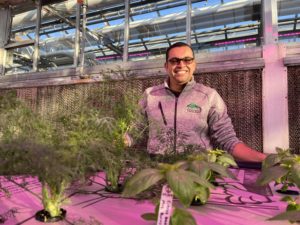
5 Universities Partner on USDA Grant on Culinary Herbs
Late last year, Michigan State University received a $3.4 million USDA Specialty Crop Research Initiative (SCRI) grant to evaluate the profitability and environmental sustainability of fresh-cut and potted culinary herbs produced in controlled environments (greenhouses and indoor farms).
Now, the team is in place, led by Roberto Lopez, associate professor in the Michigan State University department of horticulture, and research is underway.
The multi-institutional research and outreach team called Controlled Environment Agriculture Herb Extension and Research Base (CEA HERB) includes investigators from Michigan State (MSU), Iowa State (ISU), North Carolina (NCSU), Texas Tech University (TTU), the University of Tennessee (UTK), and the USDA Agricultural Research Service (USDA ARS).
The U.S. market for fresh culinary herbs — leafy plants such as basil, cilantro and parsley that add flavor, aroma or garnish — is a burgeoning one. According to the U.S. Agency for International Development, popularity of the specialty crop increased 10% to 12% annually and has continued to climb. At this point, domestic field production and imports have been used to keep pace with demand. Culinary herbs are divided into two market segments: fresh cut for the leaves and stems, and potted plants. Roughly 69% of domestic fresh-cut herbs are field grown in Arizona, California, Florida, Hawaii and Texas, and nearly $300 million worth are imported each year. But both field production and imports face mounting challenges, such as diseases, droughts and floods, foodborne illnesses, environmental impact and supply chain disruptions.
The Team

Led by Lopez, other participating MSU researchers are Bridget Behe and Erik Runkle, professors in the department of horticulture, and Mary Hausbeck, a University distinguished professor in the department of plant, soil and microbial Sciences. Other researchers and extension specialists include Kellie Walters in the department of plant sciences and Alicia Rihn in the department of agricultural and resource economics at the UTK, Brian Whipker in the department of horticultural sciences at NCSU, Christopher Currey in the department of horticulture at ISU, Angela Shaw in the department of animal and food Science at TTU, and Jennifer Boldt in the application technology research unit at the USDA-ARS.
“Growing fresh culinary herbs in controlled environments offers a multitude of benefits, including less environmental impact by reducing inputs, the ability for year-round production, and offering high-quality, flavorful and nutritious foods that have a longer post-harvest shelf-life,” Lopez said. “But there are still impediments to the industry reaching its full potential, which heightens the need to educate growers on cost-effective production techniques, boosting yields, improving flavor, color, and post-harvest shelf-life, increasing food safety and much more.
“Consumer demand for locally-grown, pesticide-free, safe produce drives our team to provide growers and distributors with information to fuel their growth and profitability.” Commercialization and use of high-intensity, energy-efficient light-emitting diodes (LEDs) gives growers control over plant architecture, height, flavor and aroma by simply adjusting light quality and intensity. Lopez said that a lack of dedicated research to culinary herbs and uncertainties of the return on investment have prevented many potential growers from taking the plunge to controlled-environment production. The goal of the 4-year project is to show current and prospective growers that there are production and sustainability benefits that cannot be replicated in the field. “Fresh culinary herbs are a small specialty crop with little financial backing for research,” he said. “That makes projects such as this even more essential.”
“Right now, production is localized to a relatively small geographic area domestically, and there’s a reliance on imported fresh cut herbs and even potted herbs from Canada,” Lopez said. “Greenhouse production provides a unique opportunity to distribute production across the U.S. by taking seasonal climate variability largely out of the equation.”
Research Methods
The team will first conduct a survey that touches on varying production methods, sensory experiences and marketing strategies. The questionnaire will capture feedback from roughly 1,700 participants around the country, assessing their perceptions of the product and their willingness to buy fresh culinary herbs at premium prices if the product is of high quality. Some participants will taste test an assortment of culinary herbs and provide input on which sensory characteristics they value. A product choice experiment using eye-tracking technology will also provide insight into the traits gravitated to by customers.
Secondly, researchers will perform controlled-environment studies to identify practices that increase growth, quality, shelf-life, disease management and food safety. Finally, the group will use the results from the survey and lab to create effective marketing, production, plant protection, technology adoption, post-harvest and food safety resources for growers. Print and electronic publications will be developed, in addition to webinars, videos and in-person presentations with growers and industry stakeholders.
“We need to perform research trials at commercial facilities to test and validate our results, of course, but to truly understand what may help grow the industry, we also need to better understand consumers,” Lopez said. “Consumer profile development will allow for the identification of new markets and aid in increasing demand for U.S. grown, fresh culinary herbs. It’s important that this project is a holistic research and outreach effort.”


 Video Library
Video Library 




















